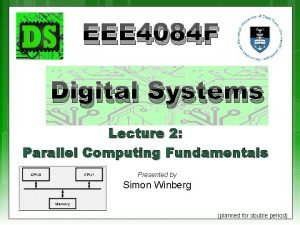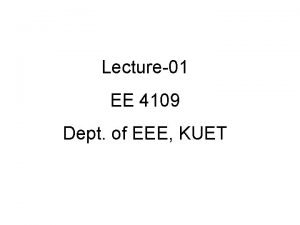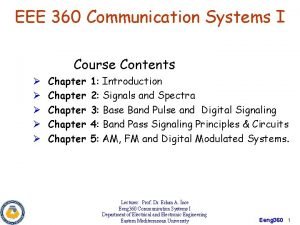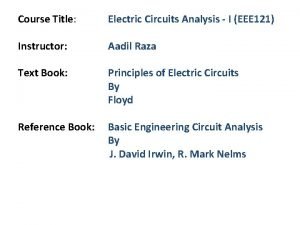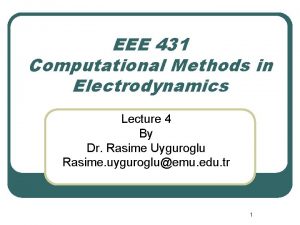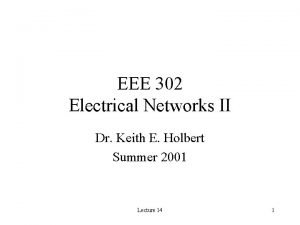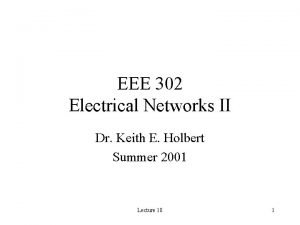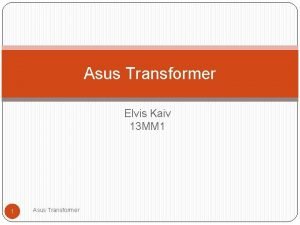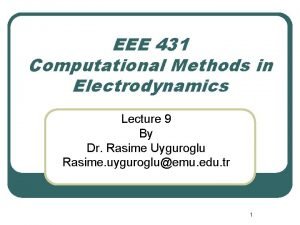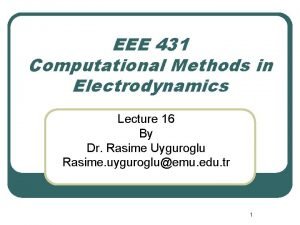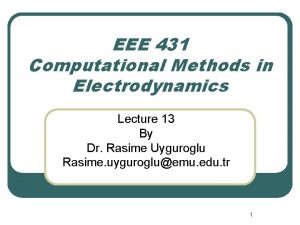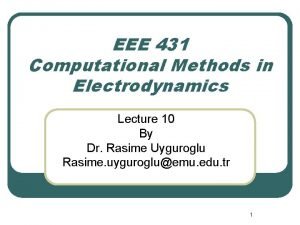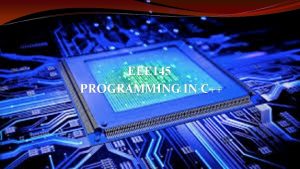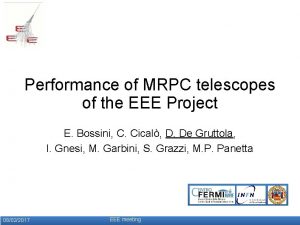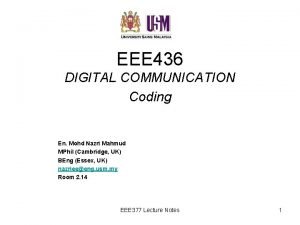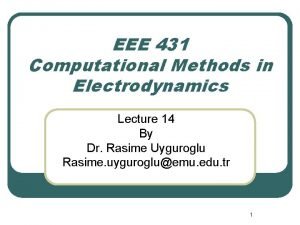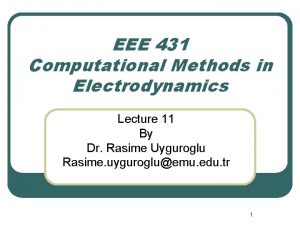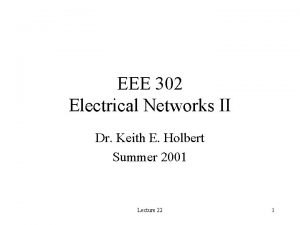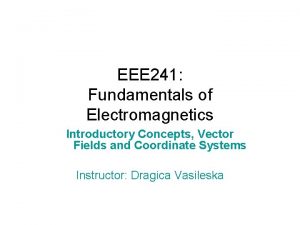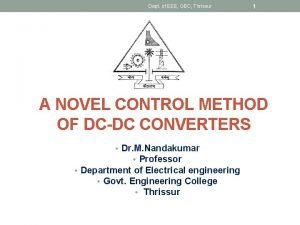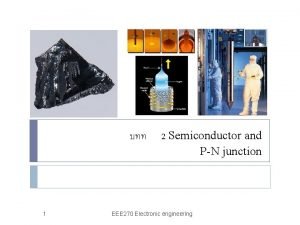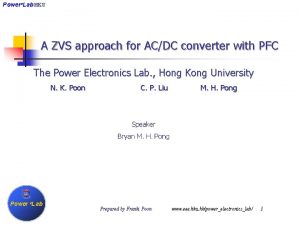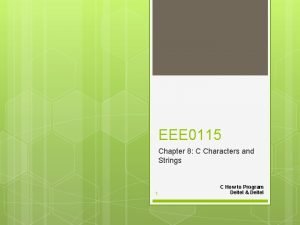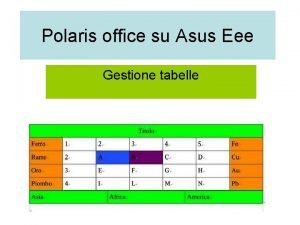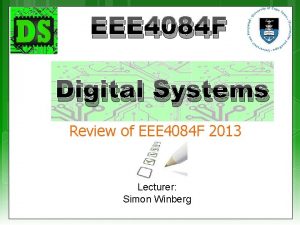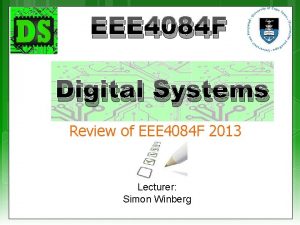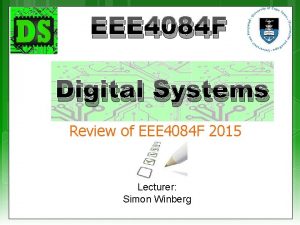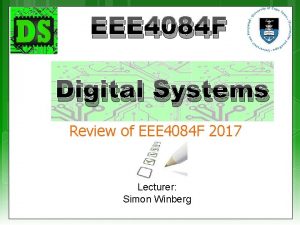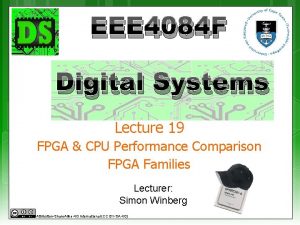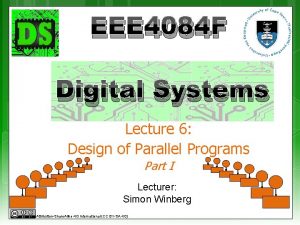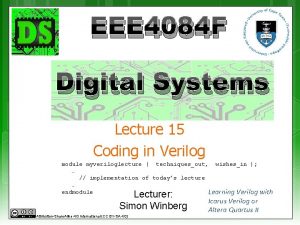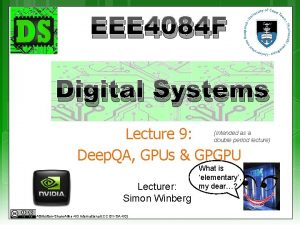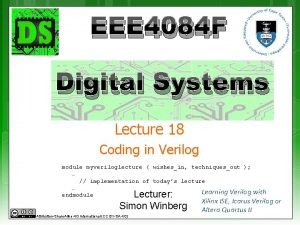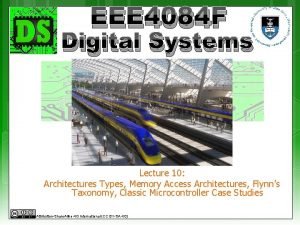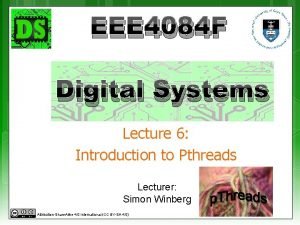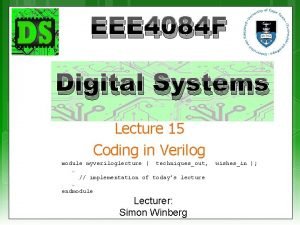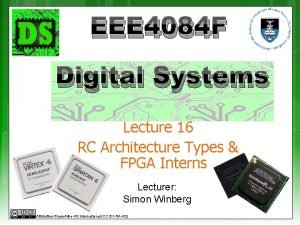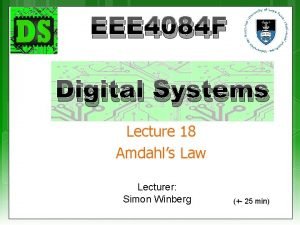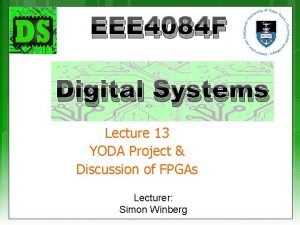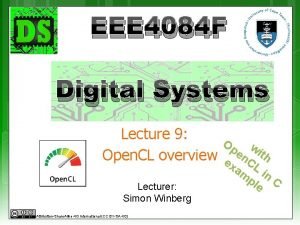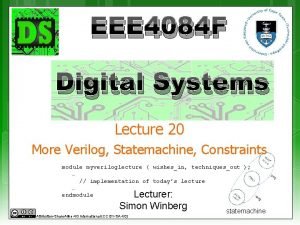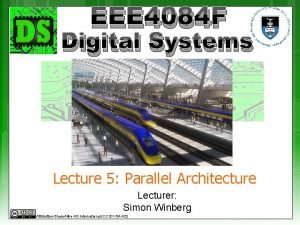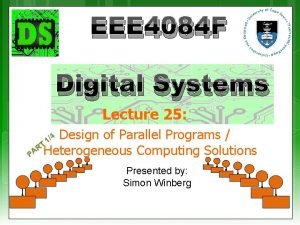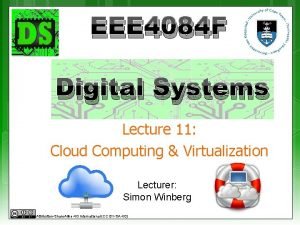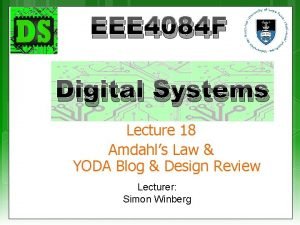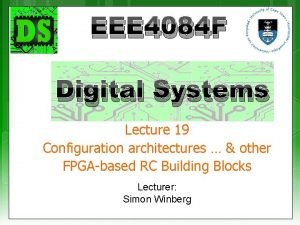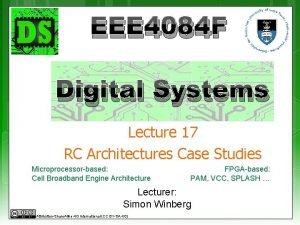EEE 4084 F Digital Systems Review of EEE






























- Slides: 30

EEE 4084 F Digital Systems Review of EEE 4084 F 2015 Lecturer: Simon Winberg

Lecture Overview Lecture content covered Readings, seminars, chapters EEE 4084 F

Digital Systems Lecture Review EEE 4084 F Digital Systems

Lecture 1 Nothing of Lecture 1 is examined

Lecture 2 Skip irrelevancies re quiz 0 (but note the contentrelated questions are still relevant and might just be asked again) All the rest is relevant UML – Unlikely but might just check if you still know your component connectors form your aggregation connectors Parallel computing fundamentals Automatic parallelism Performance benchmarking Trends

Lecture 3 Skip initial slides (1 -8) Terms. Golden Measure Temporal & spatial computing Benchmarking Power Study suggestion: Think of ways to implement parallel vector scalar and cross products and measure the performance and other results of this

Lecture 4 All Relevant. Review of homework (scalar product) Parallel programming. Timing in C Important terms Parallel programming models: Data parallel model; Message passing model; Shared memory model; Hybrid model Know the terms: Contiguous, Partitioned (or separated or split), Interleaved (or alternating), Interlaced

Lecture 5 Processor Von Architecture types Neumann; Flynn’s taxonomy Memory access architectures

Lecture 6, 7*, 8**, 9, 10 Design of Parallel Programs The main steps: 1. Understand the problem 2. Partitioning (separation into tasks) 3. Decomposition & Granularity 4. Communications 5. Identify data dependencies 6. Synchronization 7. Load balancing 8. Performance analysis and tuning * Lecture 7 Saturn V and the LVDC not examined (no need to watch the video). ** Lecture 8 includes effective bandwidth and related issues which are particularly important. Also has cloud computing. Lecture 9 includes steps 5 and 6 which are covered in the exam

Lecture 8 additional points Very relevant: Cost of communication Latency, bandwidth, effective bandwidth (and related calculations) Blocking/non-blocking; synch/asynch Scope of communications Cloud computing (virtualization and other key technology factors)

Lecture 9 Deep. QA, GPUs, CUDA First part of lecture 9: Deep. QA / IBM Watson – should know about (don’t need any detailed understanding of it) GPUs & CUDA GPU issues and benefits Important CUDA-related terms (threads and blocks) Rest of lecture 9 relates to design of parallel programs (specifically: 5. data dependencies and 6. synchronization) which is relevant

Lecture 9, 9 B, 10 cont. Should know about GPUs, benefits and principles of programming them (you won’t be asked Open. CL, CUDA or Open. GL coding) Don’t need to know any specifics of cloud computing or how to program it; more know what it involves and its service approach No need to know details of virtulization, or what the different cloud computing models are, or detail of the specific services offered Should know about load balancing be able to explain what it means and how it can be performed.

Lecture 11 Discusses the parallel programming design patterns (i. e. slides 3 -12 relevant) Ignore slides 13, 14 Slides 15 onwards relevant. Concerns terms: application accelerator, verification, validation

Lecture 12 All relevant – recaps programmable logics, HDL and VHDL

Lecture 13 Skip slides 1 -26 Have a look over slides 27 Note you don’t need to memorize details about these FPGA manufacturers or their products, but know at least: What does ACTEL focus on? (low power small packages) What does TABULA focus on? (spacetime FPGA technology for very high capacity)

Lecture 14 Description of Reconfigurable Computing, why it is ‘trendy’ Dual processing issues Skip slides 15 onwards (these are only relevant in terms of knowing what sort of things are put into hardware)

Lecture 15 Know the very basics of Verilog coding. You might be asked to Represent a (simple) combinational logic circuit in Verilog, or Translate Verilog to VHDL, or Translate VHDL to Verilog A Verilog cheat sheet will be provided Remember: module, constants, wires vs. registers, data types, parameters, initial Cheat sheets available in exams for this course follow on the next slides…

Verilog Cheat Sheet

Formulas Cheat Sheet

Lecture 16 From slide 5 onwards… RC architectures relevant, also the determining factor whether a computer platform is or is not RC Recap of FPGAs Calculating speed of a combinational logic design, and comparing computing speed with a CPU

Lecture 17 RC architecture case studies All relevant, but you need only understand the general concepts; you don’t need to remember specifics (i. e. you won’t be asked very specific things like does the L 2 cache in the cell processor connect to the PPU or the EIB)

Lecture 18 Amdahl’s law relevant Know what is meant by BCE (base core equivalent) in terms of multiprocessor chip design (ignore the last slides about the calculator, no need to read the paper) Lecture 18 a – Softcores & Picoblaze Slide 3 -5 relevant

Lecture 19 All relevant Configuration architectures Nothing will be asked re the Scott Hauck (1998) paper Other FPGA-based RC Building Blocks Memory types Digital logic modular design (slide 21) DMA Latches & flip flops

Lecture 20 Start from slide 7 DMIPS, Dhrystone, Whetstone, Coremark C HDL automatic conversion Should know how to use the Handle. C notation to write a C-style representation of a digital logic circuit Know techniques for clocking, synchronising components, passing control signals. Knowing your C logic operators (& | ^ ~) goes without saying

Lecture 21 + textbook Ch 4 ment Manage rt o p sup thod d me soun Good leadership on the process. Discussion of how the spiral model would be actioned in the case of a HPEC / reconfigurable computer / digital design Key steps and stumbling blocks in the design process RAD approach applied to digital system development Common causes of project failure Causes of project success ology Reflections

Chapters / Seminar Review EEE 4084 F Digital Systems Please see announcement concerning the chapters (copied on next slide)

EEE 4084 F May 2015 Preparation for the FInal Exam Pages of text book examinable Ch 1 3 -11; 13 (but for this chapter you only really need to read over from pp 3 to half-way though pg 5). Ch 2 15 -21; 24 (but from sect 2. 4 that starts on pg 23) - 27 Ch 3 29 -35 Ch 4 41 -45 + sect 4. 4 66 -69 (but 4. 4 you can look over but no need for specifics) Ch 5 73 -78; 88 -89; 96 -101 Ch 7 149 -155; 159 -170 (don't need to worry about the trends discussed in 7. 5. 1 -7. 5. 3 but you need to know what ENOB etc is) Ch 9 191 -196; 200 -201; 207 (from sec 9. 8) - 210 (inc. 9. 9. 3) Ch 10 217 -226 Ch 13 267 -269; 271 -272; 274; 276 -278 (excluding 13. 4. 2. 3 and 13. 4. 2. 4) Ch 14 283 -300 i. e. all relevant Ch 17 347 -356 (but you need not know the specifics, e. g. info about the various math libs discussed; seminar 9 is a good guide for what is relevant to cover) Ch 18 359 -378 (but you can skip the detailed case studies re radar and other specialized details -- the main aspects were anyway covered in the lectures) Ch 22 425 -436 Should know about the principles, won't be asked to remember in detail for instance how a turbo encoder works but the sort of question on this topic may involve a case study where you'd need to provide comms advice for instance. Ch 24 463 -469; 473; 475 -476 Berkeley paper (Seminar #0) R 01 Berkeley 2006 - Landscale of Parallel Computing Research. pdf Relevant pages: pp 1 -2 ; pp 3 -8 (don't need to know what each of the 7 dwarfs are); pp 14 -15 (composition of drawfs is relevant in terms of discussing dwarfs) excl. Sect 4. 3; pp 20 -22 (ignore 4. 1. 2); pp 44 -45. Note that much of the content of this paper is covered in more detail in the textbook and lectures.

Readings, Seminars & Chapters Resources / Handouts: LECT 01 Common Parallel Computing Terms Required Reading. pdf Resources / Homework & Class Activities EEE 4084 F Lecture 18 Class activity. pdf Handle. C-Example. zip Handle. C_Syntax. pdf Class activities (see Lecture Resources directory in the Vula resources for the course)

Readings, Seminars & Chapters Resources / Readings Compton=Reconfigurable Computing A Survey of Systems and Software. pdf NOT EXAMINED THIS YEAR Hauck 1998=The Roles of FPGAs in Reprogrammable Systems. pdf R 01 Berkeley 2006 - Landscape of Parallel Computing Research. pdf The Von Neumann Architecture. pdf

End of EEE 4084 F Lectures! Good luck with the exams And look forward to… Enjoying the Vacation!!!
 Q6 4084
Q6 4084 Kuet eee
Kuet eee Analog communication
Analog communication Ankara university
Ankara university Eee 121
Eee 121 Eee 431
Eee 431 Eee 302
Eee 302 Eee 302
Eee 302 Tahvel.edu.eee
Tahvel.edu.eee Eee 431
Eee 431 Eee 431
Eee 431 Eee 431
Eee 431 Eee 431
Eee 431 Eee 145
Eee 145 Eee
Eee Huffman coding
Huffman coding Eee 431
Eee 431 Eee 431
Eee 431 3 phase short circuit
3 phase short circuit Quality factor of rlc circuit
Quality factor of rlc circuit Dot product
Dot product Eee
Eee Animacionet
Animacionet Eee
Eee Android (linux-based)
Android (linux-based) Powere
Powere Cute pdf
Cute pdf Schematic arrangement of diesel power plant
Schematic arrangement of diesel power plant String conversion
String conversion Eee components
Eee components Eee office
Eee office
